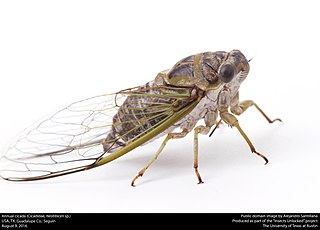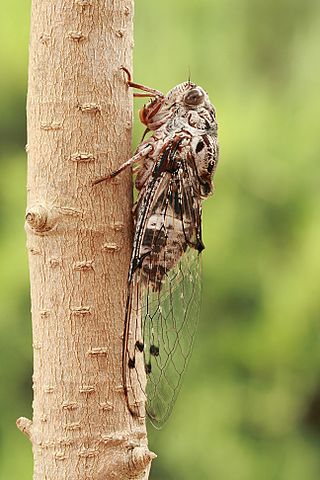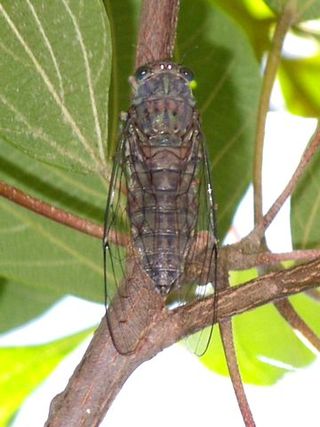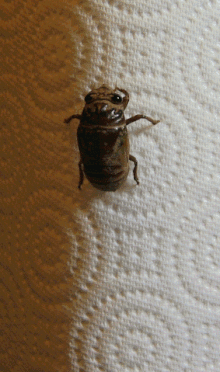
The cicadas are a superfamily, the Cicadoidea, of insects in the order Hemiptera. They are in the suborder Auchenorrhyncha, along with smaller jumping bugs such as leafhoppers and froghoppers. The superfamily is divided into two families, the Tettigarctidae, with two species in Australia, and the Cicadidae, with more than 3,000 species described from around the world; many species remain undescribed. Nearly all of cicada species are annual cicadas with the exception of the few North American periodical cicada species, genus Magicicada, which in a given region emerge en masse every 13 or 17 years.

Cicadidae, the true cicadas, is one of two families of cicadas, containing almost all living cicada species with more than 3,200 species worldwide.
In biology, exuviae are the remains of an exoskeleton and related structures that are left after ecdysozoans have molted. The exuviae of an animal can be important to biologists as they can often be used to identify the species of the animal and even its sex.

The Cicadinae are a subfamily of cicadas, containing the translucent cicadas. They are robust cicadas and many have gaudy colors, but they generally lack the butterfly-like opaque wing markings found in many species of the related Tibiceninae.

The chorus cicada, Amphipsalta zelandica, is the most common species of cicada in New Zealand, where it is endemic and found in most areas. They typically live in forests and areas with open bush, where their left-over nymph skins can be seen on tree trunks and branches during the summer months. The males produce their cicada sound in unison, which can reach deafening proportions at the height of their population around February. Groups of cicada can suddenly transition from the typical cicada sound to synchronised clicks, using their wings to clap against the surface they are sitting on.

Aleeta is a genus of cicadas with the only species Aleeta curvicosta, one of Australia's most familiar insects. Native to the continent's eastern coastline, it was described in 1834 by Ernst Friedrich Germar.

Psaltoda plaga is a species of cicada native to eastern Australia, from Maryborough in central Queensland to Bega in southern New South Wales. Adult cicadas appear over the summer and inhabit forested areas near bodies of water. The predominantly black form from the Sydney and Central Coast regions is commonly known as the black prince, while the term silver knight is used for the species as a whole.

Soundscape ecology is the study of the acoustic relationships between living organisms, human and other, and their environment, whether the organisms are marine or terrestrial. First appearing in the Handbook for Acoustic Ecology edited by Barry Truax, in 1978, the term has occasionally been used, sometimes interchangeably, with the term acoustic ecology. Soundscape ecologists also study the relationships between the three basic sources of sound that comprise the soundscape: those generated by organisms are referred to as the biophony; those from non-biological natural categories are classified as the geophony, and those produced by humans, the anthropophony.
Selymbria is a genus of cicadas in the family Cicadidae, found in the Neotropics. There are about six described species in Selymbria.

Cicadettini is a tribe of cicadas in the family Cicadidae. There are at least 110 genera and 520 described species in Cicadettini, found worldwide except for the Neotropics.
Prasiini is a tribe of cicadas in the family Cicadidae. There are about 9 genera and at least 50 described species in Prasiini, found in tropical Africa, Australasia, and the Neotropics.
Taphurini is a tribe of cicadas in the family Cicadidae, found in the neotropics.
Arenopsaltriini is a tribe of cicadas in the family Cicadidae, found in Australia. There are at least two genera and about seven described species in Arenopsaltriini.

Cosmopsaltriini is a tribe of cicadas in the family Cicadidae. There are at least 90 described species in Cosmopsaltriini, found in Southeast Asia, Australasia, and Oceania.
Nelcyndana is a genus of cicadas in the family Cicadidae, found in southeast Asia and the Philippines. There are about five described species in Nelcyndana.

Leptopsaltriini is a tribe of cicadas in the family Cicadidae. There are at least 200 described species in Leptopsaltriini, found in the Palearctic, Nearctic, and Indomalaya.

Macrotristriini is a tribe of cicadas in the family Cicadidae. There are at least 2 genera and 20 described species in Macrotristriini, all found in Australia.

Oncotympanini is a tribe of cicadas in the family Cicadidae, found in China and southeast Asia. There are at least 3 genera and about 12 described species in Oncotympanini.

Psaltodini is a tribe of cicadas in the family Cicadidae, found in Australia. There are at least 3 genera and about 17 described species in Psaltodini.
Psithyristriini is a tribe of cicadas in the family Cicadidae, found in the Philippines. There are about 7 genera and at least 100 described species in Psithyristriini.


















